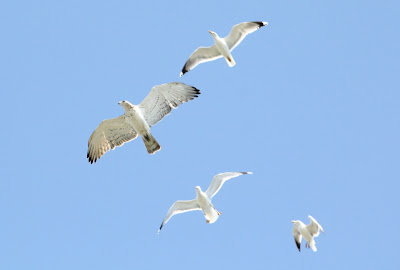You may have seen a report of a possible Iberian Chiffchaff on various websites which was trapped and ringed at Radipole yesterday. Well, that would be my fault. I had the nets up for an hour late morning doing a ringing demonstration for some very keen visitors and came across a bird in the net, as you do... The bird suggested Willow Warbler (in appearance, not actually suggested through words) to me initially before I looked at it properly whilst extracting it. It was indeed a Chiffchaff but I remember extracting Iberian Chiffs in Gibraltar and they tended to give more of a Willow Warbler impression when approaching one in a net.
It was ringed and I quickly took a wing formula from it which came out as wing point = P4, 2nd primary = 6/7, emargination on P6. The interesting bit is the 2 = 6/7, which means that the second primary on a closed wing fell between the 6th and 7th primary feather. Common Chiffchaff would normally come out as 2 = 8 or 8/9, 9 and sometime 9/10.
Plumage looked interesting as I’ve already hinted. Overall quite green with bits of yellow. Bare parts were rather colourful, bill was quite orange and legs were fairly pale. Rump appeared slightly brighter than the rest of the body. Also a nice feature was the slight continuation of the supercillium over the bill. All interesting stuff but I couldn't back it up properly with good photo’s! All I had on me was a bloody phone so had to use that for photo’s and the very dull light wasn’t helping. Also, let the bird go fairly quickly as it wasn’t in the best of conditions which if fair enough considering it probably migrated a fair distance overnight and needed to feed up. These were the best I could manage!
Head shot showing the bright supercillium, especially in front of the eye. The quite orange bill and interestingly little bits of yellow and a whitish throat. Also note the slightly long billed appearance which is sometimes a suggested feature though one or two papers say otherwise.
Leg complete with bright soles.
Back showing the slight brighter rump
The whole bird which I must admit doesn’t look quite as striking as it did in the hand but I guess there’s only so much a phone can do.
So on release I was hoping for a nice interesting call but instead it bounded off into the reeds never to be seen again which kind of ended the idea of Iberian Chiffchaff. I hope you agree the pics look interesting but they could have been better! Ideally I could have run off to get my proper camera but obviously the birds welfare came first. Nevermind...






























